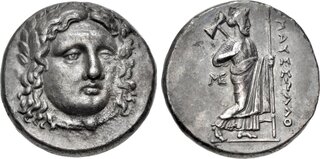| Classical Numismatic Group > Triton XXVII | Auction date: 9 January 2024 |
| Lot number: 285 Price realized: 2,250 USD (Approx. 2,061 EUR) Note: Prices do not include buyer's fees. | Show similar lots on CoinArchives Find similar lots in upcoming auctions on |
| Lot description: SATRAPS of CARIA. Maussolos. Circa 377/6-353/2 BC. AR Tetradrachm (23.5mm, 14.79 g, 1h). Halikarnassos mint. Struck circa 370-360 BC. Head of Apollo facing slightly right, wearing laurel wreath, drapery around neck / Zeus Labraundos standing right, wearing chiton and himation at his waist and wrapped around his left arm, holding labrys and inverted spear; ME monogram to left, MAYΣΣΩΛΛO to right. Konuk, Identities 21; Babelon, Perses 397 var. (no monogram); HN Online 227; SNG von Aulock 2358; SNG Kayhan 873; SNG Lockett 2907 = Pozzi 2624; BMC 8; Traité II 95. Toned, traces of find patina, minor cleaning marks, minor delamination on edge. Good VF. Ex Grand Haven Collection (Triton XXIV, 19 January 2021), lot 714 (hammer $3750). As part of the Achaemenid Empire, Caria in the fourth century BC was under the rule of a family of semi-independent satraps known as the Hekatomnids after the dynasty's founder, Hekatomnos. Born in Mylasa, Hekatomnos was appointed satrap of Caria by Artaxerxes II after the fall of Tissaphernes in 392/1 BC and was later given control of Miletos in 386 BC. A philhellene who was, in turn, admired by the Greeks, Hekatomnos died in 377/6 BC and was succeeded by his son, Maussolos, who became the most famous Carian Satrap. At the time of Maussolos' accession, Achaemenid power was weakened by the independence of Egypt and a revolt of the subject Kadusioi. As a result, the satraps of Asia Minor were able to exercise considerable independence; an opportunity of which Maussolos took full advantage. Moving the satrapal capital to Halikarnassos, he fortified the city and allowed its population to increase in size. As part of the civic building program, he constructed a massive tomb for himself near the city's center. Known later as the Mausoleum, its size and elaborate decoration made it one of the Seven Wonders of the ancient world. In addition, Maussolus moved and refounded the Greek cities of Knidos, Erythrai, and Priene. His relations with the Persians took a downturn when he briefly joined the Great Satrap Revolt, a series of rebellions that continued to spring up in the Persian Empire throughout the 360s, all of which ultimately failed. For the remainder of his rule thereafter, Maussolos continued to act more or less independently, although he had to accept a Persian garrison in Halikarnassos. When Maussolus died in 353/2 BC, his sister-wife, Artemisia, succeeded him. Her rule was short-lived, and in 351/0 BC power passed to Hidrieus, Artemisia's brother and the second son of Hekatomnos. Hidreius played a double-dealing game, nominally supporting his Persian overlords while secretly negotiating with the aggressive Macedonian King, Philip II. In 341/0 BC, Pixodarus, the youngest son of Hekatomnos, overthrew his sister, Ada, to claim the Carian satrapy. Ada, nevertheless, continued to receive support from the countryside, and still held the city of Alinda. As a result, Caria was thrown into turmoil and hesitated to support Persia with troops following the invasion of the Macedonians under Parmenion in 336 BC. Pixodaros, however, had secretly been forging diplomatic alliances with the Macedonian king. In 337 BC, he attempted a marriage between one of his daughters and the future Philip III Arridaios. Believing himself overlooked, Alexander III sent a private embassy to Halikarnassos, asking for the hand of the same princess. When word of this reached Philip II, he cancelled the Macedonian-Carian alliance. When Pixodaros died in 336/5 BC, he was succeeded by Orontobates, an otherwise unknown Persian. After Caria was conquered by Alexander III in 332 BC, the Macedonian made diplomatic overtures to Ada, and reappointed her as satrap. Ada, the last Hekatomnid, died sometime before the Partition of Bablylon in 323 BC and was replaced as satrap of Caria by the Macedonian Asander. Estimate: 2000 USD |  |



